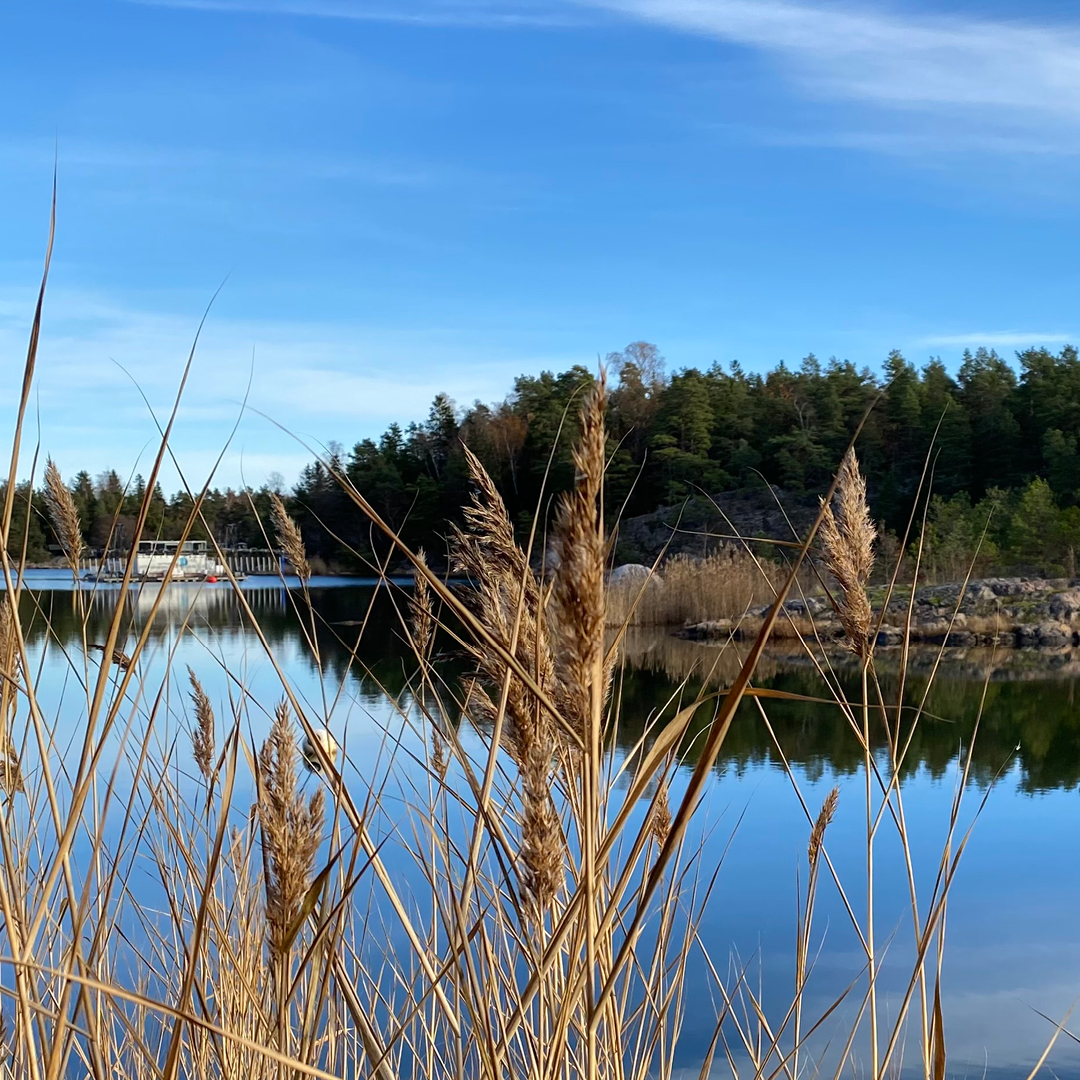If you have read about eutrophication in the Baltic Sea, you will probably have come across the term internal load, usually followed by the expression ‘past sins’. This refers to nutrients, mainly phosphorus, that have been added to the sea over time and accumulated in the sediments. In the bottom sediments, the nutrients do not cause any major problems, but when the bottom water becomes oxygen-depleted, the phosphorus is released back into the water. The increased nutrients in the water drive eutrophication and thus the growth of phytoplankton and algae. When they die, they sink to the bottom and decompose, consuming oxygen and releasing phosphorus back into the water. It becomes a vicious cycle that is difficult to break.
But it can be broken, at least in enclosed deeper water areas such as lakes and sheltered bays with limited water exchange. This has been done many times in lakes and a few times in coastal bays using aluminium treatment. The result is reduced eutrophication with clearer water where underwater vegetation can grow and fish and small animals can hunt for food and seek shelter. But what is puzzling is that even small shallow bays, which are only a few metres deep, have a small catchment area and no oxygen-depleted bottoms, sometimes exhibit similar problems. How is this possible? And is it possible to break the vicious circle even in shallow bays? This is what the researchers within Thriving Bays are trying to find out.
As a systems ecologist, focusing on the Baltic Sea coastal zone and project manager for Thriving Bays, Linda Kumblad has encountered many eutrophicated bays. Eutrophication in the Baltic Sea bays can be caused by many different factors, such as emissions from substandard sewage systems, leakage from animal farms and agriculture. And internal loading.
‘The Baltic Sea is an enclosed sea, so the nutrients released into the sea remain there for a long time. Free phosphorus binds to iron, calcium and aluminium, which are naturally present in the bottom sediments. Iron is the most common binder in the sediment, but its ability to bind phosphorus disappears if the sediment becomes oxygen-free. In the past, when oxygen-depleted bottoms were less widespread, there was a balance between phosphorus and binders. But in recent decades, oxygen-depleted bottoms have become more common and phosphorus inputs from land have increased, creating an imbalance between binders and phosphorus’, says Linda.
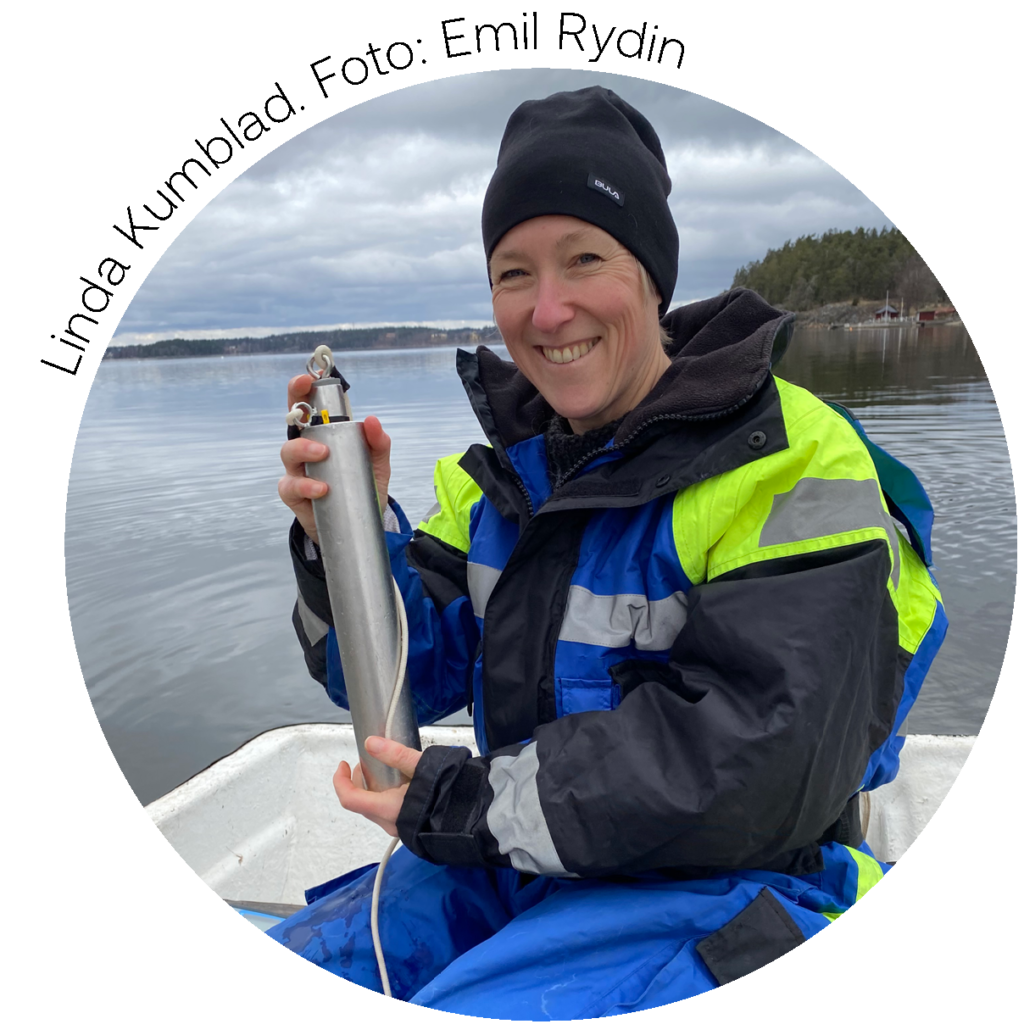
Aluminium, on the other hand, binds phosphorus even when it is oxygen-free, which is why aluminium treatment has been used successfully in lakes since the 1960s to curb internal loading and the vicious cycle. And in 2012, it was implemented for the first time in a sheltered bay – Björnöfjärden on Värmdö.
‘The treatment is still having a positive effect on water quality in Björnöfjärden. Eutrophication has decreased and the water is clearer, allowing sunlight to reach further down, which means that underwater vegetation can grow deeper,’ says Linda.
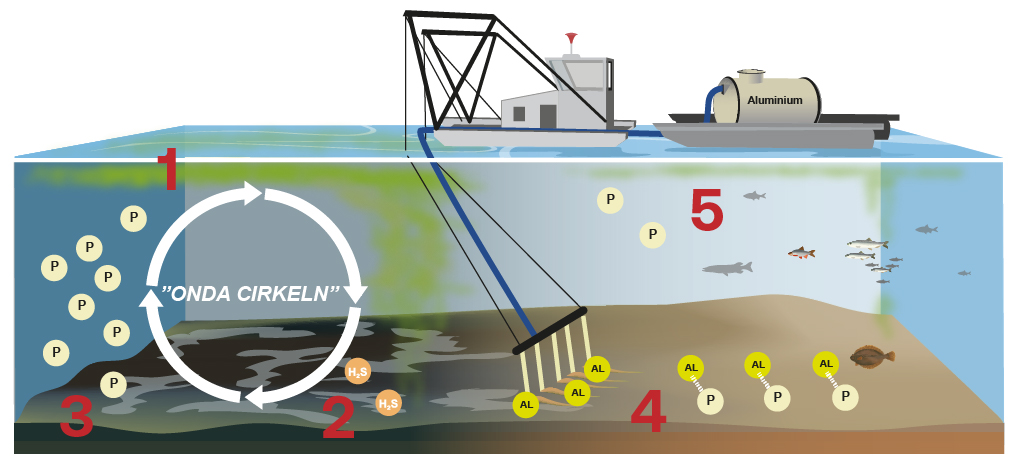
1. When there is a lot of nutrients in the water, the growth of phytoplankton and other algae increases.
2. When the algae die, they sink to the bottom and decompose. During decomposition, oxygen is consumed and nutrients are released. When the oxygen is depleted, hydrogen sulphide (H2S) is formed, which is toxic.
3. In healthy sediment, phosphorus (P) is bound to iron, aluminium and calcium. In oxygen-depleted bottoms, the binding capacity deteriorates and phosphorus is released into the water, contributing to eutrophication.
4. The aluminium mixture is carefully blended into the sediment and binds phosphorus permanently.
5. When the leakage of phosphorus from the sediment into the water is reduced, algae growth also decreases – the vicious cycle is broken. For the effect to last, it is important that no new nutrients enter the water.
When the Thriving Bays project got underway in 2020, Linda and her colleagues came across shallow sea bays that were heavily eutrophicated and had a palpable internal phosphorus load. One of the project bays, Högklykeviken on Gräsö, was one of them. But in this case, the nutrients did not appear to originate from land-based sources.
‘It was strange, the bay has an average depth of only 2 metres, there were no major nutrient sources from land and the bay is so shallow that it shouldn’t be struggling with oxygen-depleted areas. But still, it was very eutrophicated – one of the most eutrophicated bays we’ve seen,’ says Linda.
But it hasn’t always been like this. In the past, Högklykeviken had clear waters with underwater meadows teeming with life. Now the water was cloudy, the stonewort was gone and there was hardly any fish recruitment.
Linda’s colleague Emil Rydin, a limnologist at Stockholm University’s Baltic Sea Centre, has previously grappled with another shallow, eutrophic bay. More specifically, Granfjärden in Östhammar, which has an average depth of 3 metres. Like Björnöfjärden and Högklykeviken, internal loading is the bay’s biggest problem.
‘Attempts to bind phosphorus in such shallow bays present a different set of challenges compared to deeper bays. In shallow, enclosed bays, the water mass is more mobile throughout the year, which means that bottom sediments can be stirred up. The pH can also vary over the year, which is unusual in deeper bays. A high pH can dissolve the bond between aluminium and phosphorus, and then we are back in the vicious cycle, says Emil.
In Granfjärden, Emil conducted enclosure experiments in 2019 with several different binders such as marl, aluminium and iron, and the results pointed to a binder that was perhaps a little unexpected.
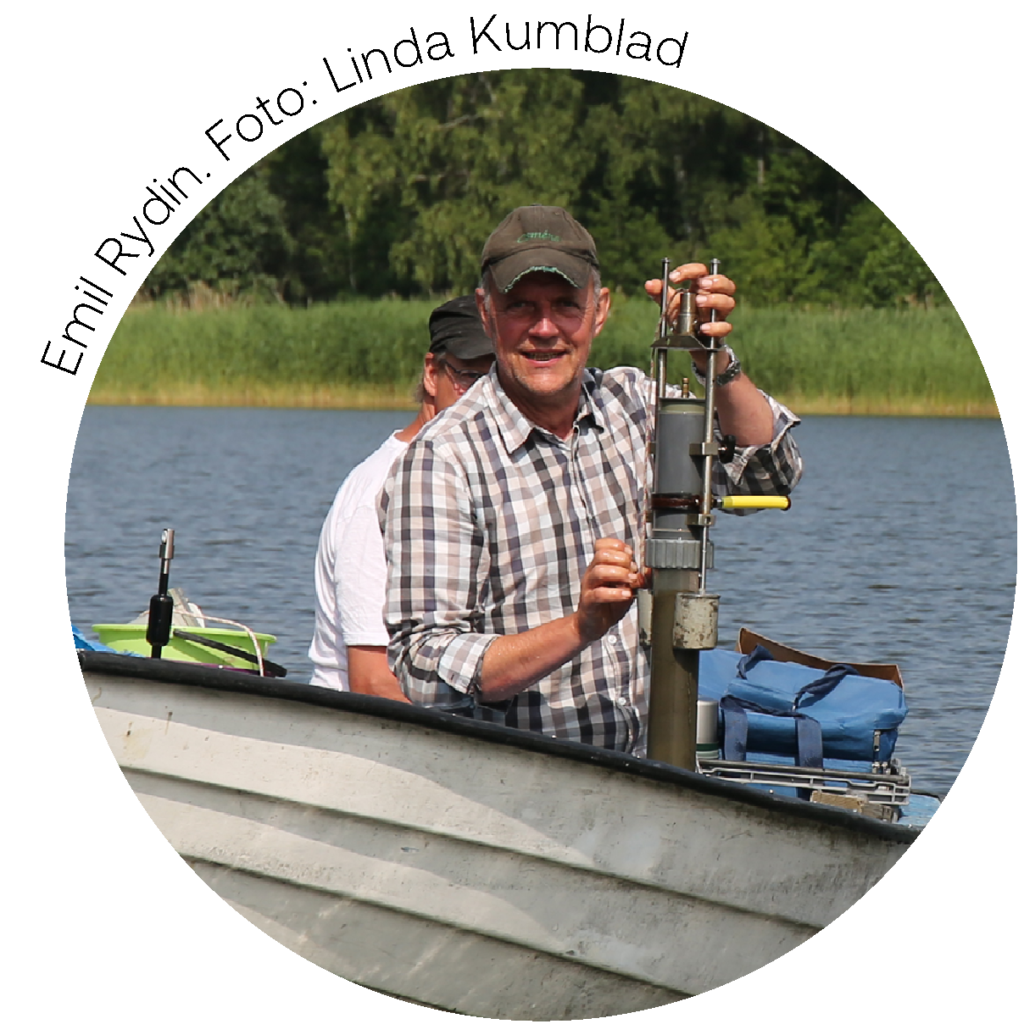
‘Aluminium proved to be the most effective binder after all. Another reason we went ahead with aluminium was that, even though the bay is shallow, the bottoms become oxygen-free at times. So we tried adding aluminium to 10 x 10 metre squares at the bottom of Högklykeviken, and we got a clear binding of the phosphorus in the sediment to the added aluminium instead of the phosphorus leaking into the water,’ says Emil.
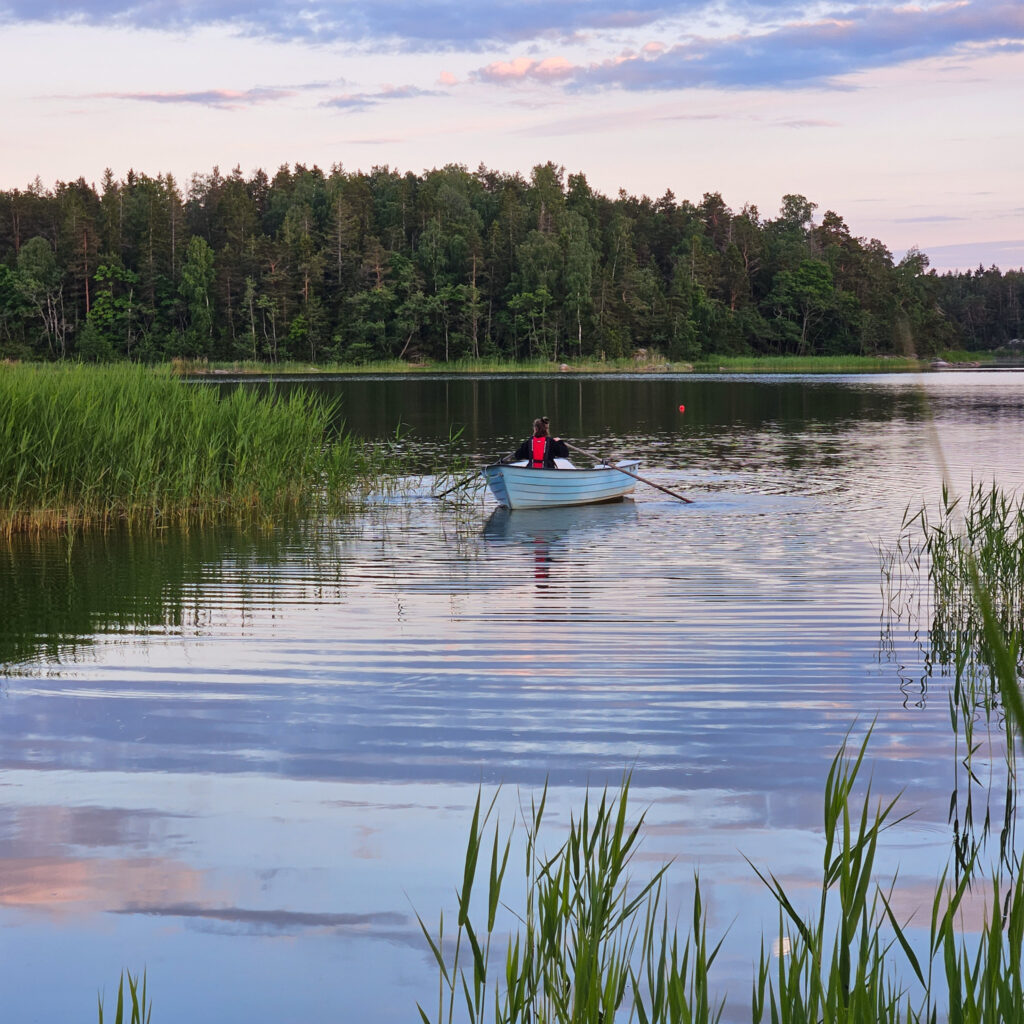
But where do the nutrients come from? After several years of sampling, the cause of the internal load became clear.
‘Högklykeviken has a long, narrow channel that connects it to the bay outside. The channel was dredged about 25 years ago to improve access to the bay, and this exposed nutrient-rich silt. The dredging also increased the flow of water into the bay, bringing nutrients and silt particles from the channel and increasing beach erosion,’ says Emil.
Photo: Sofia Wikström
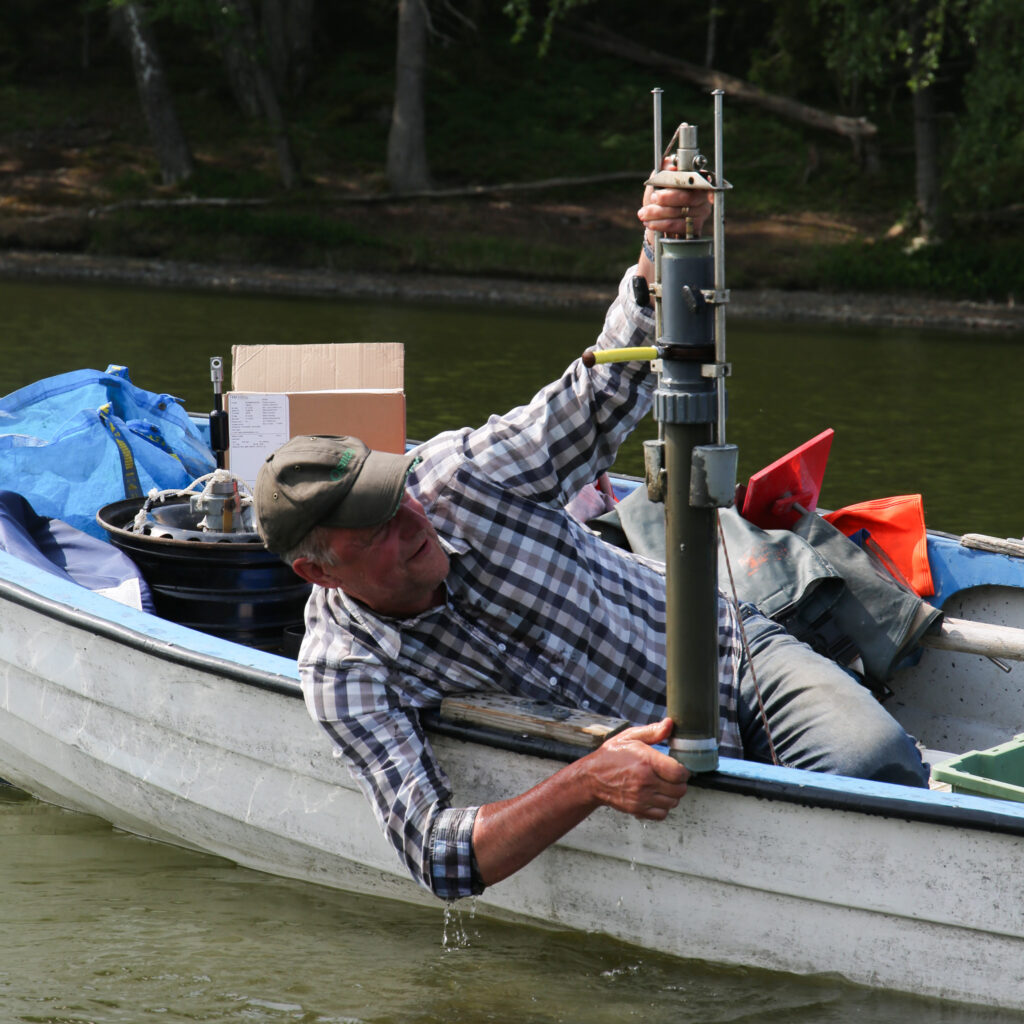
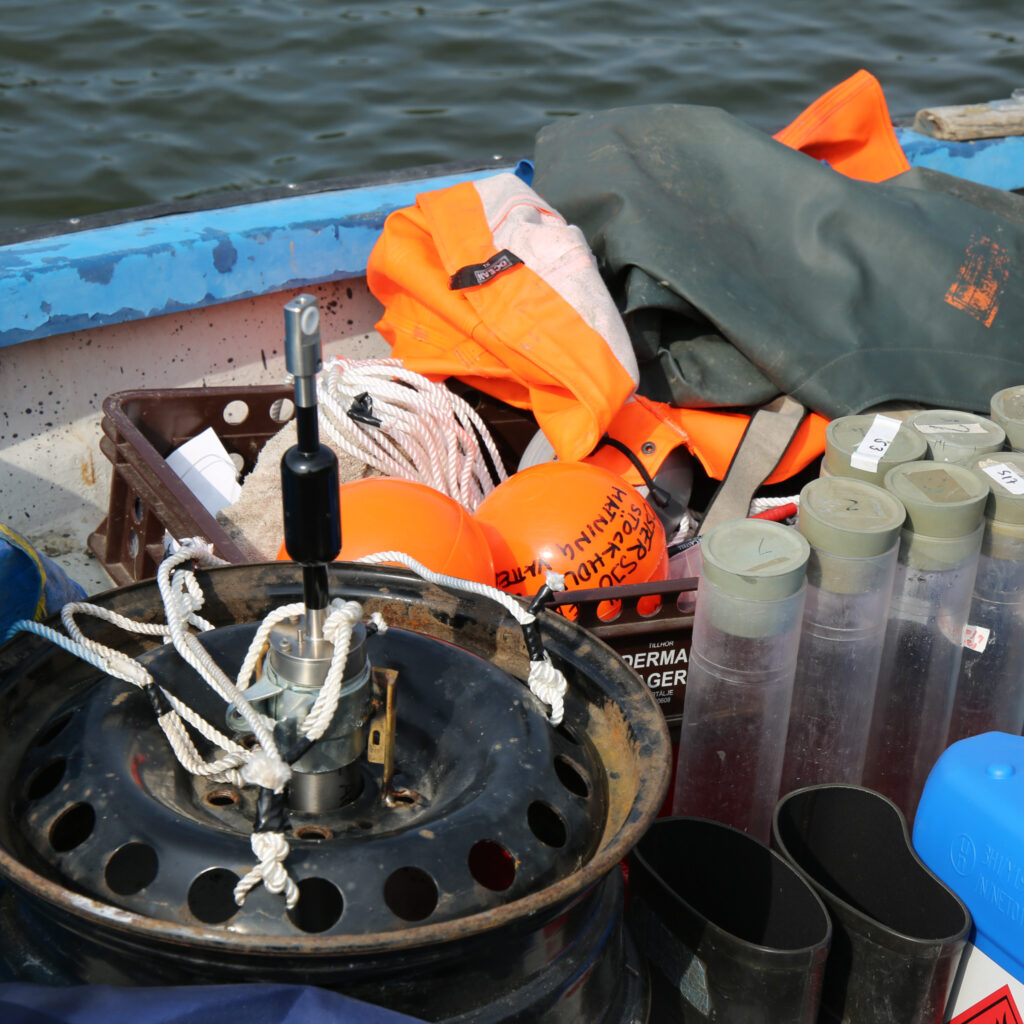
Rigorous sampling has been carried out to investigate where the nutrients in the bay come from. Photo: Linda Kumblad
No one around Högklykeviken suspected that the severe eutrophication in the bay was caused by the dredging. And that is understandable.
‘The effect of dredging is not one of the classic sources of eutrophication. But in the Thriving Bays project, we have come across several bays that are, to a greater or lesser extent, affected by previous dredging,’ says Linda.
Dredging can change the environment over a long period of time, for example by creating so-called dredging wounds that leak nutrients. Nutrient leakage from the Högklykeviken canal has been going on for two decades and seems to have accumulated in the bay, where a high internal load has built up, resulting in severe eutrophication.
To get the eutrophication in the bay under control, both the dredging wound in the canal had to be repaired and the nutrients that had accumulated in the bay had to be bound in the sediments.
During the latter part of 2024, crushed stone was placed in and along the entire 300-metre-long canal to reduce the exposure of the clay bottom to water movement.
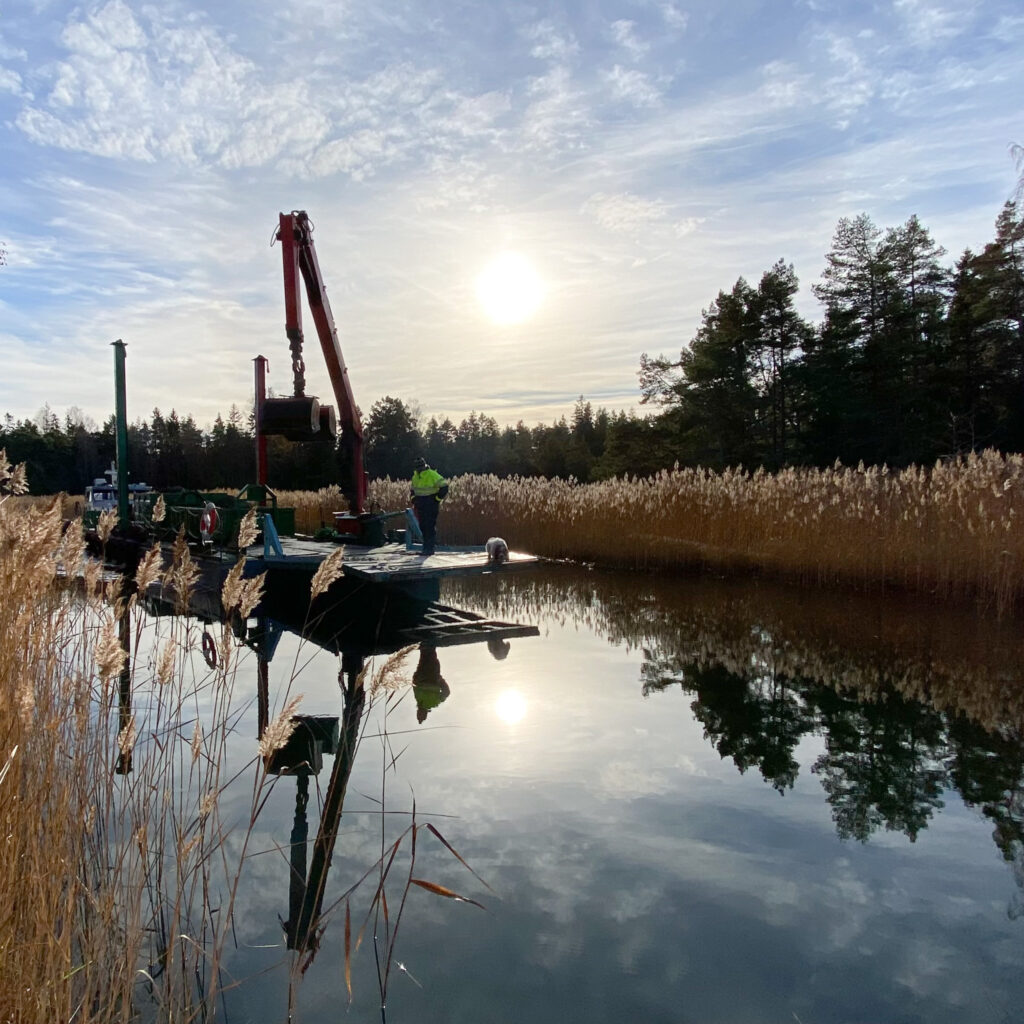
Crushed stone is placed as erosion protection in the 300-metre-long canal leading into Högklykeviken. Photo: Linda Kumblad
In this way, Linda and Emil hope that the new supply of nutrients from the canal into the bay will cease. To bind the phosphorus in the sediments and thus break the vicious cycle, an aluminium treatment is being carried out. As this is the first time that aluminium treatment has been carried out in such a shallow bay as Högklykeviken, the treatment is being carried out in several small steps, with low doses and small areas at a time, with measurements and evaluations in between. The first treatments were carried out in spring 2024, followed by additional treatments in the autumn. Throughout 2025, the project will monitor how the bay responds to the treatment, and in 2026, the final treatments will be carried out. But Linda and Emil saw results already after last year’s partial treatments.
‘Phosphorus levels have decreased by about 20 per cent, and we hope that the following partial treatments will contribute about the same,’ says Emil.
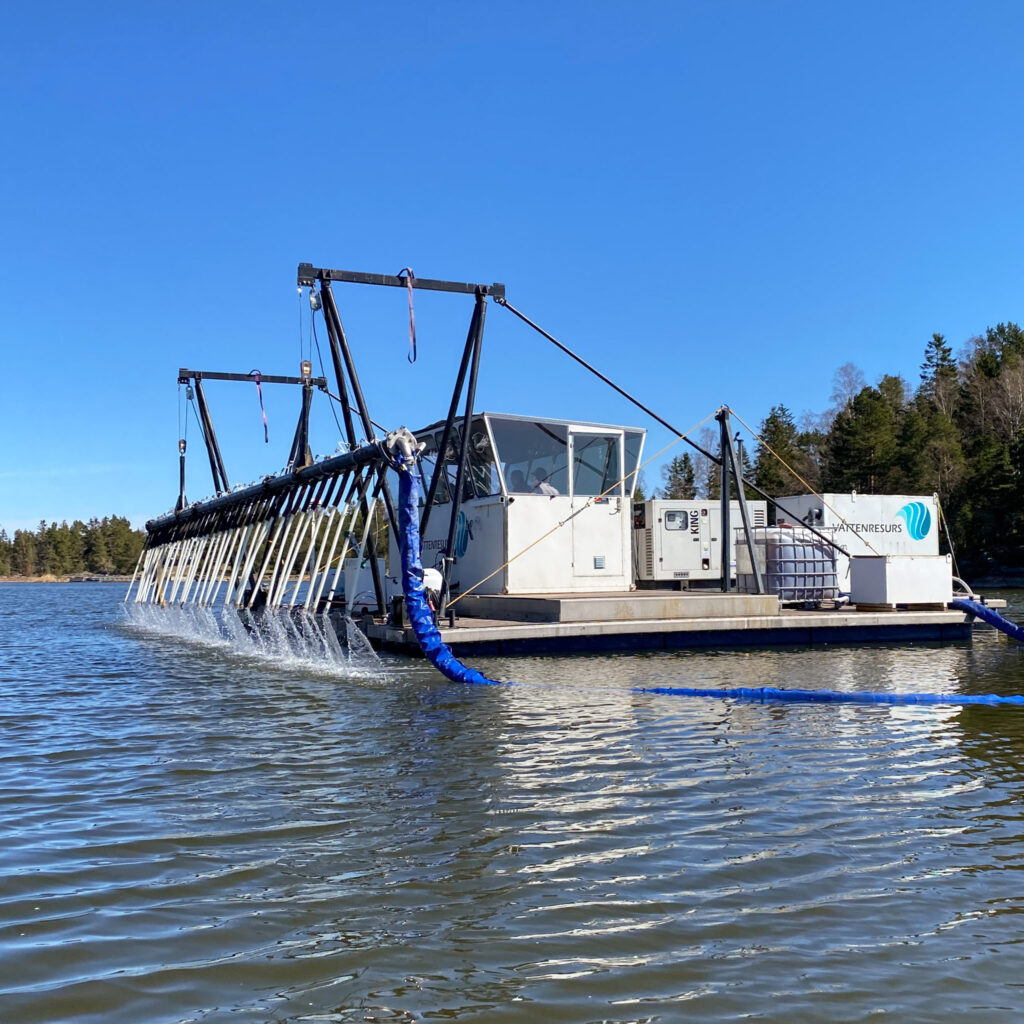
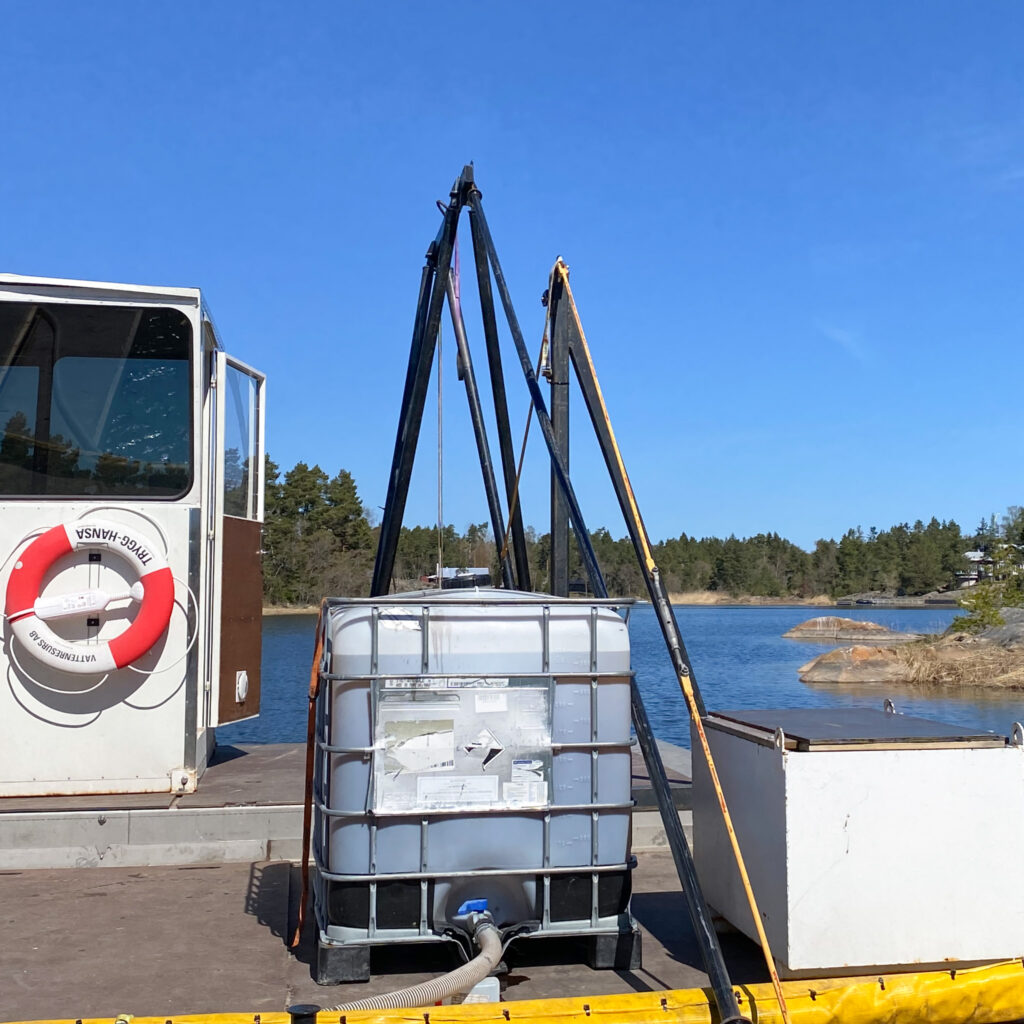
The boat mixing aluminium into the sediment during one of the treatments in spring 2024. Photo: Linda Kumblad
The hope is that the aluminium treatments, combined with the erosion protection in the canal, will significantly improve the environment in the bay, so that residents and visitors can once again experience Högklykeviken as it used to be.
‘The results indicate that we are heading in the right direction, but we know that recovery can take time, so we must be patient. With the experience gained from this project, we hope to spread knowledge and inspiration so that more bays along our coast can be restored and bays facing the same challenges as Högklykeviken can curb the internal loading. So the vicious cycle can be broken, says Linda.

More about Thriving Bays
The aim of the the project is to try to show that it is possible to improve the environment in shallow bays and to develop knowledge about how this can be done in a cost-effective way. The project will work to test and evaluate individual measures in a number of case studies, and full-scale restoration in some shallow bays along the Svealand coast will be carried out. Thriving bays runs until 2027 and is implemented and financed by BalticWaters with financial support from, Stockholm University’s Baltic Sea Centre, the Stockholm County Administrative Board and the Uppsala County Administrative Board . The Swedish Agency for Marine and Water Management has allocated funds to Stockholm University for the implementation of sampling and monitoring in the project bays.
